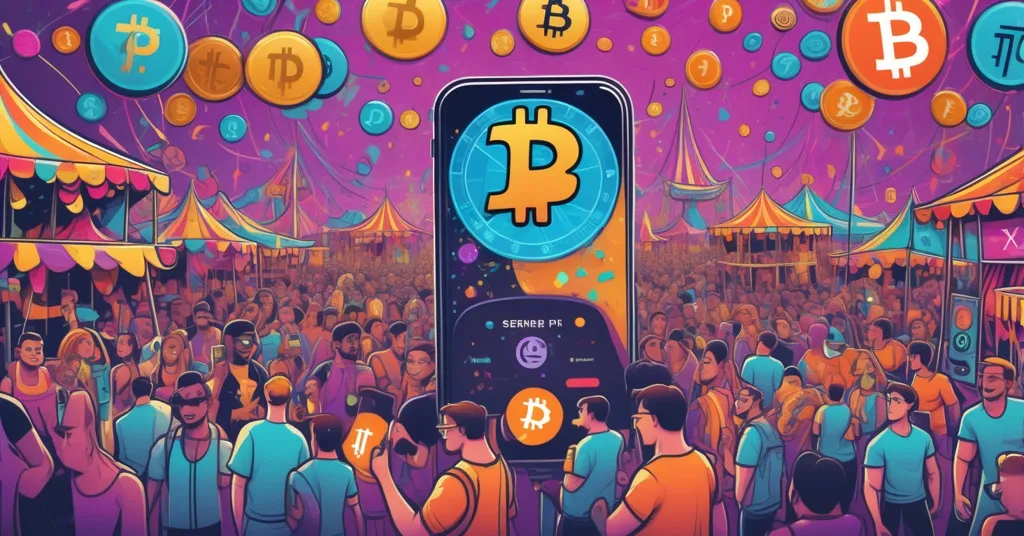Pi Network Token Unlock Looms as XYZVerse Hype Sparks Debate: Real Value or Hype?

Pi Network Token Unlock Nears as XYZVerse Hype Ignites—Speculation or Substance?
Two cryptocurrency projects are making waves in the crypto sphere: Pi Network, with its upcoming mainnet launch and mobile-first approach, and XYZVerse, a meme coin riding a presale frenzy with promises of astronomical returns. While Pi aims to democratize access to blockchain, XYZVerse is banking on viral hype. Let’s cut through the clutter, examine both projects with a critical eye, and weigh their potential against the bedrock of Bitcoin’s principles.
- Pi Network Milestone: Mainnet launch set for Q1 2025, with over 18 million KYC-verified users prepped for token migration.
- XYZVerse Buzz: Presale surpasses 70% of a $15M goal, fueled by wild claims of 10,000% to 20,000% gains.
- Reality Check: Hype dominates both narratives, but centralization risks and unverified data demand scrutiny.
Pi Network: Mobile Mining and the Quest for Inclusivity
Since its launch on March 14, 2019—cleverly timed as Pi Day—Pi Network has positioned itself as a game-changer in crypto accessibility. Founded by Stanford graduates, it ditches the energy-hungry mining rigs of Bitcoin’s Proof-of-Work system for a smartphone app that lets anyone “mine” tokens without draining wallets or the planet. It operates on the Stellar Consensus Protocol (SCP), a mechanism where users form trust circles—think of it as a digital neighborhood watch where friends vouch for each other to secure the network. Unlike Bitcoin’s brute-force computational battles, SCP aims for efficiency, though it risks centralization if trust isn’t widely distributed. For a deeper dive into how this works, check out the Pi Network mobile mining explanation.
By January 2025, Pi Network claims over 60 million registered users, with more than 18 million having completed Know-Your-Customer (KYC) verification—a process ensuring user identity for regulatory compliance and token migration to the mainnet (the live, operational blockchain). Over 8 million have already migrated their tokens, with the full “open network” phase slated for Q1 2025 after delays from late 2024 due to technical and verification hurdles. This phase could see Pi tokens become tradable on exchanges, potentially onboarding millions into crypto, especially in regions where mining hardware or high electricity costs make Bitcoin a non-starter. Picture a farmer in a remote village earning digital currency with just a phone—that’s the dream Pi sells. To understand more about the founders and project credibility, take a look at this update on Pi Network’s open network phase.
How Mobile Mining Works
For the uninitiated, Pi’s mining doesn’t involve solving complex math like Bitcoin. Instead, users tap a button daily to confirm activity, earning tokens based on their network of trusted contacts. It’s low-barrier, low-energy, and designed for mass adoption. No need for a $5,000 GPU rig or a power bill that rivals a small factory. But simplicity comes at a cost—security and decentralization take a backseat to user-friendliness, a trade-off Bitcoin purists grimace at.
Centralization and Other Concerns
Here’s where the cracks show. Despite the user numbers, on-chain activity paints a less rosy picture, with analysts at Cointelegraph noting inflated engagement metrics. Pi’s reliance on centralized control for network operations clashes with the self-sovereign ethos of blockchain. Its business model, leaning on ad revenue to fund operations, feels more like a tech startup than a decentralized revolution. And with an inflationary token supply—unlike Bitcoin’s strict 21 million cap—long-term value is a gamble. Then there’s the KYC requirement, raising privacy red flags in an era where governments crack down on crypto anonymity. Could Pi be a noble experiment in inclusivity, or just a data-harvesting app dressed in blockchain clothing? As Bitcoin maximalists, we can’t help but raise an eyebrow at these compromises. For more on these issues, see this analysis of Pi Network’s centralization risks.
XYZVerse: Meme Coin Frenzy or Fleeting Fantasy?
Switching gears, XYZVerse is the latest meme coin to storm the scene, blending sports fandom with internet meme culture to capture the viral magic of Dogecoin or Shiba Inu. It’s in the midst of a presale, starting at $0.0001 in Stage 1 and climbing to $0.003333 by Stage 12, with over 70% of a $15 million fundraising goal reportedly secured and a final target of $0.1. Its tokenomics look structured on the surface: 15% of the supply is allocated to liquidity to stabilize trading and prevent sudden price crashes, 10% goes to community rewards through airdrops and bonuses, and 17.13% is reserved for deflationary burns—reducing total supply over time to potentially boost scarcity and value. For a detailed breakdown, refer to this XYZVerse presale transparency analysis.
Presale Breakdown and Partnerships
The hype is deafening. CoinMarketCap supposedly shows a 95% bullish sentiment among its community, though such metrics can be gamed. A partnership with bookmaker.XYZ, a decentralized sportsbook, offers betting bonuses for $XYZ holders, a neat hook for sports enthusiasts. An Ambassador Program hands out free tokens to active members, driving grassroots excitement. Crypto influencer DanjoCapitalMaster, boasting nearly 800,000 followers, has dubbed it a game-changer. To explore more about this influencer’s stance, check out the DanjoCapitalMaster endorsement reviews.
“XYZVerse a ‘moonshot opportunity’” – DanjoCapitalMaster, crypto influencer
Red Flags in Meme Coin Hype
Hold your horses—let’s not get sucked into the vortex. Claims of 10,000%, 50X, or even 20,000% returns are absolute hogwash, smelling fishier than week-old sushi. Where’s the market analysis? The historical precedent? Nowhere. Meme coins are a notorious graveyard—Chainalysis data shows over 90% fizzle out within a year, often leaving investors with empty bags. Transparency is another issue: there’s no verifiable data on presale progress or the legitimacy of partnerships. Influencer endorsements? Likely paid. Bullish sentiment? Easily manipulated. Remember the Squid Game token debacle of 2021, where hype led to a rug pull costing investors millions? XYZVerse could be cut from the same cloth. We’re all for disruptive ideas, but this reeks of a cash grab preying on FOMO-driven retail investors. Bitcoin’s value wasn’t built on fairy tales—why should we entertain this nonsense? For a broader perspective, see this discussion on meme coin legitimacy.
Analysis: Innovation, Speculation, and Bitcoin’s Shadow
Pi Network and XYZVerse sit at opposite ends of the altcoin spectrum, each reflecting broader trends in the crypto space. Pi offers a tangible vision of inclusivity, targeting users Bitcoin can’t reach due to its technical and economic hurdles. Its mobile mining could spark real adoption in developing markets—think of a street vendor in Africa joining the digital economy. Yet, centralized control and an unproven economic model keep us wary. XYZVerse, meanwhile, embodies the wild, speculative frontier of crypto, tapping into niche communities with sports and memes. It might foster vibrant engagement, a role altcoins can play outside Bitcoin’s store-of-value niche, but without transparency, it’s a lottery ticket at best, a scam at worst.
From a Bitcoin maximalist perspective, neither fully embraces the cypherpunk ideals of unstoppable, censorship-resistant money. Pi trades sovereignty for scale; XYZVerse seems to trade everything for hype. Look at recent government crackdowns on centralized exchanges—decentralization isn’t just ideology, it’s survival. Yet, as proponents of effective accelerationism, we see value in messy experimentation. Bitcoin doesn’t need to solve every problem; altcoins test ideas, fill gaps, and sometimes crash spectacularly, teaching us what fails. The question is whether Pi or XYZVerse offers genuine innovation or just noise. Could Pi redefine access to blockchain, or will it buckle under its own compromises? Is XYZVerse a cultural spark for sports fans, or another rug pull waiting to happen? For community concerns around Pi’s launch, see this Reddit thread on mainnet launch issues.
Regulatory Risks and Future Outlook
Neither project is immune to external pressures. Pi’s heavy KYC requirements could clash with privacy laws or attract scrutiny in restrictive regions, where governments view crypto as a threat. XYZVerse, if its hype draws attention, risks regulatory backlash—meme coin scams often catch the eye of bodies like the SEC, eroding trust in the broader space. Success for Pi could pave the way for mobile-first blockchains, reshaping how we think about adoption. Failure might expose the limits of accessibility without decentralization. If XYZVerse flops, it could deter niche meme coin experiments—or just weed out weak players. Either way, the crypto revolution thrives on bold swings, but not blind faith. For insights into potential high-growth plays beyond utility tokens, explore this piece on Pi token unlock and XYZVerse speculation.
Through the Bitcoin Lens: Skeptical but Hopeful
Let’s ground this in Bitcoin’s principles of decentralization, privacy, and freedom. Pi Network’s accessibility is a noble aim, but centralization risks betray the ethos that birthed crypto—a system no single entity can control. XYZVerse’s speculative nature undermines the idea of sound money, prioritizing quick bucks over lasting value. Bitcoin remains the unshakeable foundation, forged through a decade of resilience. Altcoins have a place to push boundaries, test use cases, and reach corners Bitcoin doesn’t—provided they deliver substance over smoke. We’re hopeful for experiments that drive adoption, but skeptical of anything that smells like a shortcut or a grift.
Key Takeaways and Questions for Crypto Enthusiasts
- What’s the potential of Pi Network’s mainnet launch in 2025?
It could onboard millions with its mobile-first model, especially in underserved regions, but centralized control, inflationary supply, and past delays cast doubt on long-term value and true decentralization. - Is XYZVerse presale a legitimate investment opportunity?
Highly unlikely—unsubstantiated claims of 10,000% to 20,000% returns, coupled with zero transparency on presale data or partnerships, scream high risk. It’s more gamble than investment. - How do Pi Network and XYZVerse align with Bitcoin’s principles?
Poorly. Pi sacrifices sovereignty for scalability, while XYZVerse chases hype over substance. Neither matches Bitcoin’s uncompromising security and censorship resistance. - What risks should investors weigh with meme coins like XYZVerse?
Volatility is just the start. Look for verifiable presale stats, credible teams, and real use cases. Without these, you’re banking on hope—over 90% of meme coins collapse within a year. - Can altcoins like Pi and XYZVerse contribute alongside Bitcoin?
Yes, if they target genuine niches—accessibility for Pi, community for XYZVerse. But innovation must trump gimmicks, and both need to prove they’re more than passing fads.
The crypto space is a crucible of ideas, and projects like Pi Network and XYZVerse embody the chaos and creativity that define it. Pi’s token unlock and mainnet push deserve a watchful eye as a bold stab at mass adoption, flaws and all. XYZVerse, frankly, looks like the frothy garbage that stains this industry’s reputation. We stand for disrupting the status quo, but not at the cost of integrity. Bitcoin is the gold standard, the anchor of decentralized finance. Altcoins can play supporting roles, but only if they stop peddling pipe dreams and start building value. Dig into Pi’s code, question XYZVerse’s promises, and stack sats while the hype dust settles. The crypto revolution is real—don’t let the noise drown it out.



